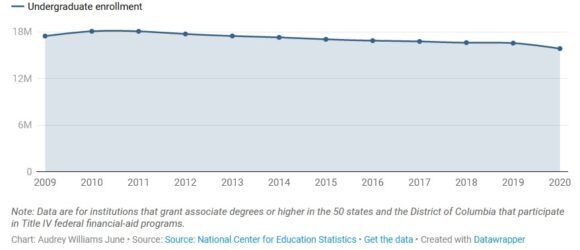Dear Commons Community,
The Chronicle of Higher Education had a featured article yesterday entitled, “The Shrinking of Higher Ed” that portends that colleges will not be able to grow their way out of the coming enrollment crisis. Here is an excerpt.
“In the past, colleges grew their way out of enrollment crises. This time looks different.
Nearly 1.3 million students have disappeared from American colleges during the Covid-19 pandemic, raising alarms that the enrollment emergency projected to arrive a few years from now is already here.
High-school seniors uninterested in studying online chose to defer. Working parents strained by the demands of full-time pandemic child care put their studies on hold. International students couldn’t get visas. Those in majors with hands-on practicums or lab work found they couldn’t register for courses required for their degrees.
Enrollment numbers continue to look bleak as the pandemic drags on, even though in-person classes have become the norm and consulates have reopened. College attendance among undergraduates has fallen almost 10 percent since Covid emerged in early 2020; this spring, enrollment dropped 4.7 percent from the year before, according to the National Student Clearinghouse Research Center, a deeper-than-expected decline.
The persistence of the enrollment contraction has sparked fears that many students are not simply missing but gone for good. Research shows that if students stop out, they may not continue with their studies, and that’s particularly true for those from disadvantaged backgrounds. “We have to act now,” said Courtney Brown, vice president for impact and planning at the Lumina Foundation. “This is a crisis moment.”
The pandemic enrollment slide has heightened worries at colleges about finances, especially among those dependent on tuition revenue to meet their bottom lines. Even before the Covid outbreak, the financial resiliency of a third of American colleges was poor, according to a new report from Bain & Company.
Inflation is driving up colleges’ operating costs, and a volatile stock market is eating into endowment returns. Small private colleges, regional public universities, and rural institutions all face strong headwinds, according to the bond agency Fitch Ratings. Federal stimulus funds that helped many colleges avert closures are running out. The outlook, said Emily Wadhwani, senior director and sector lead for higher education at Fitch, is “weak getting weaker.”
Of course, doomsday scenarios have been floated before. Time and time again, in recent decades, American higher education has grown its way out of crises. Colleges have expanded access to underrepresented groups, added academic programs and amenities to attract students and charge them higher tuition, and struck private-sector deals to tap new markets.
This time looks different. Higher ed may have reached the limits of Houdini-ing its way out of decline by getting bigger, and the prolonged pandemic downturn could be just one indication.
Public confidence in college is sinking, and students and parents think tuition is too high. Skepticism is mounting toward the idea that a college education should be the prerequisite for well-paying jobs, and in a tight labor market clamoring for workers, some people are landing them without a degree. Already, nearly seven in 10 high-school graduates immediately go on to pursue, although not necessarily complete, some sort of postsecondary education, and the remainder may be difficult to recruit. The students left out of higher education have been notoriously difficult for colleges to reach and serve. And then there’s the looming demographic cliff created by the sharp drop in birth rates that began in 2007.

“There really is an arithmetic problem here,” said Anthony P. Carnevale, director of the Center for Higher Education and the Workforce at Georgetown University. “There aren’t going to be enough students to go around.”
Reasons to worry!
Tony



